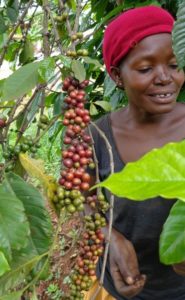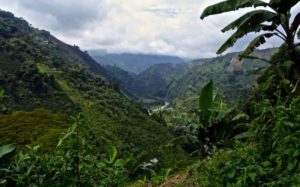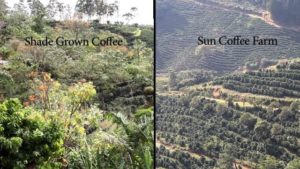Climate Change Roasting the Coffee Industry
According to 2019 market research, 63 percent of Americans drink coffee daily—and this comes as no surprise, given coffee’s various benefits. Not only does coffee provide the energy and focus many adults need before heading to work, but it also provides numerous health benefits, including protection against Type II Diabetes, Parkinson’s Disease, liver disease, and liver cancer.
Yet, within 30 years, we may be paying a higher price for less-quality coffee (as if lattes weren’t expensive enough). Recent findings illuminate the startling effects climate change has on coffee production. (Retweet this!) Like many agricultural crops, coffee is susceptible to various climate change effects, including:
- Rising temperatures and subsequent droughts
- Erratic rainfall
- Increased crop pests and diseases
- Decrease in coffee plant pollinators
- Decrease in fertile, usable soil
According to the Intergovernmental Panel on Climate Change (IPCC), 2.7 degrees Fahrenheit of global warming could be reached in as little as 11 years if CO2 emissions are not reduced substantially.
With only 1.8 degrees Fahrenheit of global warming, our planet has already witnessed the devastating effects of climate change, such as heat waves, forest fires, droughts, and floods—and rising temperatures will only devastate coffee plantations.
Effects of Climate Change on Coffee Plantations
In Uganda, which ranks number eight in worldwide coffee production, the average annual temperature has increased by 0.2 degrees Celsius every decade since the 80s, but this rate is expected to increase to another two degrees C warmer by mid-century.

Figure 1: Ugandan coffee farmer inspecting beans. Photo courtesy of NDSU
An increase in temperature coupled with erratic rainfall (which results in periods of droughts and flooding) will elicit a 50 percent cut to Uganda’s coffee production by 2050, posing serious consequences for the economy, which earns 20 percent of its export revenue from the coffee industry.
Colombia’s mountain range is witnessing a similar problem, as this region is growing warmer by 0.3 degrees Celsius per decade. Despite the increase in temperature, Colombia’s coffee plantations have lost 19 percent of sunlight due to increasing cloud cover, which has, in turn, resulted in lower levels of coffee production.
Additionally, warmer, wetter weather has encouraged the spread of fungal and insect diseases, which contributes to losses in coffee production.

Figure 2: Thickets of clouds hover over Colombian coffee range
According to research published in Proceedings of the National Academy of Sciences, in Latin America, 88 percent of coffee-producing land will be unproductive due to poor agricultural practices, and by 2050, 50 percent of coffee-producing land worldwide will be unsuitable for coffee farming.
Yet, climate change isn’t the only problem Uganda and other poor countries face. Farmers in poor regions often have limited access to equipment, such as fertilizer, high-quality seeds, and irrigation. Furthermore, they lack agricultural training, processing facilities, and, of course, money.
While coffee production is affected by erratic changes in our environment, the environment isn’t to blame. The one to blame is, quite ironically, coffee production—and the agricultural industry as a whole.
Deforestation
At least 2.5 million acres of forest in Central America were cleared for coffee farming due to the growing popularity of “sun cultivation.” Unlike traditional coffee cultivation methods, which sustainably grew coffee beneath the shade of tree canopies, “sun cultivation” requires additional sunlight to increase coffee bean yields.
By stripping the forests, we have decreased the planet’s biodiversity, revoking the habitat of many insects, plants, and animals, and by cutting down trees, we’ve accelerated climate change.

Figure 3: Deforestation caused by the increased popularity of sun cultivation. Photo courtesy of Arbor Day Foundation
In order to mitigate the effects of climate change, sustainable agricultural practices must be enforced. Practicing regenerative agriculture is an excellent way to keep the earth healthy while satisfying our needs for vitamin-rich food (and, of course, our favorite hot beverage).
A vital component of regenerative and sustainable agricultural practices is the use of natural and environmentally friendly fertilizers. Due to increased nitrogen concentrations in the soil (caused by poor fertilizer application methods as well as synthetic fertilizers), nitrous oxide (N2O) is released into the atmosphere, contributing to global warming.
Choosing a fertilizer that can uniquely and intelligently support your crops is essential to mitigating the effects of climate change.
xVital, xVirity’s liquid fertilizer, lets users adjust the amount of nitrogen per volume in order to more efficiently fertilize crops. By adjusting the ratio yourself, you can save money and decrease your impact on the environment by eradicating or limiting the potential for runoff and N2O production.
Tip: For coffee plants, use xVital during the vegetative and reproductive stages for better seed germination, water absorption, and plant growth.
Sources:
Climate Change Impacts Worse than Expected, Global Report Warns
A Dying Climate Threatens Africa’s Coffee, but Hope Remains
Your Morning Cup of Coffee is in Danger. Can the Industry Adapt in Time?
Colombian Coffee Farmers are Paying the Price for Climate Change



